John Reppion's Blog, page 7
March 28, 2023
Epomaker EK68 keyboard
The always lovely people at Epomaker recently sent me one of their EK68 keyboards to try out.
The EK68 is a 66 key / 65% keyboard, with a discreet volume knob at the top right of the keys (click to mute/unmute). It’s ANSI layout, compatible with Mac and Windows (Win/Mac mode select switch at rear), and connects via USB-C, or wirelessly via Bluetooth 5.0 or 2.4GHz Wireless (dongle stashed in a niche at the rear, next to the connection mode select switch).

The EK68 comes in a choice of Black Purple and Black Gold colourways. I got Black Gold, which my eldest son said reminded him of a JCB, but which I realised actually reminded me of a favourite book cover of mine. The key caps on the EK68 are PBT double shot Cherry Profile. On the Black and Gold keyboard, these are a mix of black, grey, and yellow, with bold yellow characters on all by the yellow keys, which have black characters.
The EK68 comes with a choice of Epomaker Flamingo, Epomaker Budgerigar, Gateron Pro 2.0 Yellow, and Epomaker Bluebird switches. I got the Budgerigars, which I thought I’d try out since I’d recently tried the Flamingos on the MC66. Later I realised that I’d already tried them on the TH96, but I loved them on that, so I’m not complaining. They’re pleasantly clicky, but not too clicky, and I really like the feel of them. That said, when Leah is sharing the office with me, she finds them a bit loud, so they might not be ideal for quiet workspaces. (You can hear a sound test of the Epomaker Budderigar switches here).
The switches on the EK68 are hot-swappable, meaning that they can be easily swapped out for any 3 or 5-pin switches of your choosing with no need for soldering or unnecessary messing about.
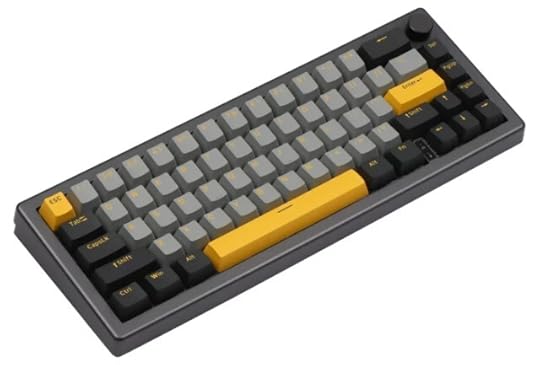 The plastic body of the EK68 has a nice grey metallic look which I thought was aluminium at first, but isn’t. The EK68 is a steel plate, gasket-mounted keyboard with Sound Absorption Foam incorporated. The EK68 weighs 830 grams on my kitchen scales, so it’s definitely light enough to be a laptop bag carry-around keyboard. A fair of flip-down silicone-footed feet give you a bit of extra angle adjustment and added stability. The Built-in 3000mAh battery is going to last you about a week from fully charged if you’re using backlights, or three times that if you’re using the EK68 without lights.
The plastic body of the EK68 has a nice grey metallic look which I thought was aluminium at first, but isn’t. The EK68 is a steel plate, gasket-mounted keyboard with Sound Absorption Foam incorporated. The EK68 weighs 830 grams on my kitchen scales, so it’s definitely light enough to be a laptop bag carry-around keyboard. A fair of flip-down silicone-footed feet give you a bit of extra angle adjustment and added stability. The Built-in 3000mAh battery is going to last you about a week from fully charged if you’re using backlights, or three times that if you’re using the EK68 without lights.
The EK68 is RGB backlit, with the usual Epomaker array of presets and customisation options. You should know by now that I almost always switch to a solid colour rather than a light effect, but the EK68 is the first keyboard which has ever made me immediately opt for a solid yellow backlight. It looks fantastic.
As a lover of 65% keyboards, the EK68 ticks a lot of boxes for me. It combines many of the elements of two of my favourite smaller boards: the Durgod Fusion and the Epomaker B21. It’s a compact, lightweight, take-anywhere kind of keyboard. It’s got everything I need for a desktop keyboard (yes, even a Del key), but it’s also perfect for on-the-go connection to a laptop or tablet. Maybe, though, you might want to opt for quieter switches if you’re thinking of working in a library, or some other quiet space.
The post Epomaker EK68 keyboard first appeared on moorereppion.March 27, 2023
Judge Dredd Megazine 454 out now
 Cover by Tom Foster
Cover by Tom FosterOUT NOW: Judge Dredd Megazine #454STORM WARNING // Dead & Gone, part six
Brit-Cit, 2147 AD. Much like its Mega-City counterpart, Brit-Cit Justice Department has its various divisions, from Tek to plainclothes, Tactical to Psi, and one of its more prickly operatives in the latter is Lillian Storm, who has the ability to talk to the dead, and is always accompanied by her ghostly helpers. Now, Storm has been seemingly laid to rest to cross into the afterlife…
 Script: John Reppion / Art: Clint Langley / Letters: Jim CampbellThe post Judge Dredd Megazine 454 out now first appeared on moorereppion.
Script: John Reppion / Art: Clint Langley / Letters: Jim CampbellThe post Judge Dredd Megazine 454 out now first appeared on moorereppion.
March 18, 2023
Gloaming Notebooks Pocket Notebook
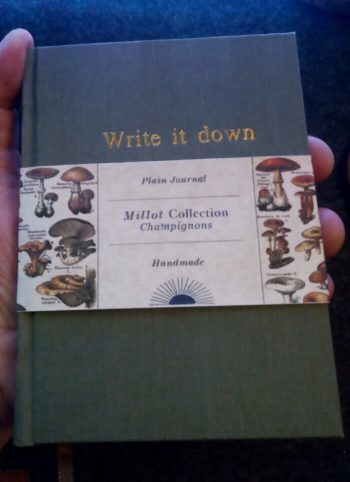
Like a lot of writers, I have a lot of notebooks. In fact, doing a very quick count, I can see that there are nine “in use” notebooks on and around my desk as I sit typing. A further six, already full or otherwise “retired” notebooks are also in view and, if I started looking harder, I’m positive that we’d soon get into the twenties and probably the thirties all too easily. That’s genuinely a bit of a surprise now I come to think about it and write it down. Maybe I actually have more notebooks than most writers.
All notebooks are not created equal, of course. All of the retired/abandoned notebooks I have here are A4, ring-bound, lined ones from the supermarket or W H Smiths. They’re useful, but they’re also cheap and disposable (although, apparently I never actually get around to disposing of them). For me, these kinds of books are mostly filled with the thumbnail page sketches Leah and I script our comics from. Yes, there are notes in there, but mostly those relate specifically to the story or series which has been roughed out across that book’s pages. We fill up a lot less of these than we used to because, if I’m writing comics solo, then I tend to use the Supernote instead of paper and pen now.

One of the “in use” notebooks I have here, to my left, is exactly that aforementioned species of ring-bound supermarket A4 book. It’s the book Leah and myself are currently using to plot and thumbnail out our Queens of the Lost World series. The other eight… well, some of those have been “in use” for more than a decade.
These are the smaller notebooks. Some are A5, but mostly they’re some variant of pocket notebook. Many are battered and frayed, stained with tea or coffee, their covers spattered with ink, some of their pages containing doodles our children did in their infancy. Some literally cost a pound or two, others considerably more. These are idea books. Portable notebooks which I have carried around in my backpack or coat pocket over years of bike rides, walks, trips to the park, journeys on the bus or train, mornings spent in stay-and-play groups, and so on. They’re the little notebooks which I rush in from the other room to grab if I hear something on the radio which makes me think “I need to write that down“. In fact, my current go-to “in use” book (which is “in use” notebook number ten, if we’re keeping count) lives on my bedside table, rather than my desk. I had to run up and grab it to make an urgent note last night, and I flicked back to the previous page after I’d done so. There was a really good idea there which, even though I had written it down very recently, I had completely forgotten about. And that’s the whole point, isn’t it?
I am not a well-organised person, and I never have been. I do not keep a diary or do journaling. Although that book on my bedside table is my current go-to “I need to write that down” notebook, the likelihood of me grabbing any of the other “in use” books to make a crucial do-not-forget-this note is still very high. A page written in 2007 might have a note on its back from 2018, only for the facing page to be filled with a To-Do list for Christmas 2009. They’re not organised. They’re not in any order. It’s chaotic, I know. I’m sorry. What they are though, is useful. Really useful. In fact, I’d argue that they’re vital. Essential.
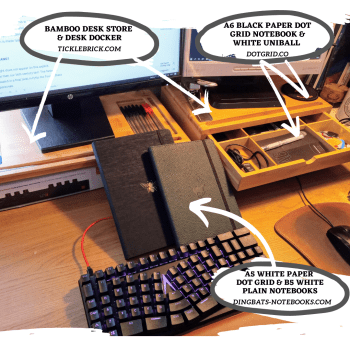
Since I started writing these reviews back in 2020, I’ve been lucky enough to be sent a handful of really nice notebooks.
Back in 2021, I got a lovely little A6 Dotgrid.co notebook. Black pages with a 4.25mm white dot grid matrix, and a white Uni-ball gel pen to go with. Like writing in negative, it’s incredibly aesthetically pleasing, but it’s not really the kind of book you make quick, random notes in.
Around the same time, I got a couple of Dingbats* notebooks: an A5+ Wildlife dot grid notebook for myself, and a plain paper Pro B5 notebook for Leah. That lovely A5+ with the stag on the front is the book I still use for my monthly to-do lists, and Leah’s B5 is now almost completely filled with her watercolours and sketches.
In 2022, Great Fountain Italy sent me one of their little 52-page, 89 x 140 mm pocket notebooks. Designed for use with a fountain pen (I do have one of those, too), I am ashamed to admit that I have never actually got around to writing in it, despite the fact that it looks and feels delightful.
Thanks very much to #GreatFountainItaly for sending me one of their lovely little pocket notebooks
— John Reppion (@johnreppion) June 14, 2022

https://t.co/Pj5xKwtsjB pic.twitter.com/xqMsmucnHN
Even though I’ve been lucky enough to get hold of all these lovely notebooks, I’ve never really properly reviewed any of them (apologies, especially to Great Fountain Italy). To be honest, I’m not exactly sure how to review a notebook. I am, however, going to give it a go, because last week Gloaming Notebooks sent me my new go-to pocket notebook.
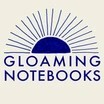
I first became aware of Gloaming Notebooks via their Instagram account earlier this year. Two things immediately caught my attention. First was the use of the word gloaming, which is a fantastic and much-underused word.
Originally used in Scottish dialects of English, the word traces back to the Old English glōm, meaning “twilight,” which shares an ancestor with the Old English glōwan, meaning “to glow.” In the early 1800s, English speakers looked to Scotland again and borrowed the now-archaic verb gloam, meaning “to become dusk” or “to grow dark.”The second was toadstools. I love mushrooms and toadstools and fungus, and one of the first posts I saw from Gloaming Notebooks was an image of one of their Adolphe Millot Champignons pocket notebooks.
View this post on InstagramA post shared by Gloaming Notebooks (@gloaming.notebooks)
I saw that and immediately felt like this was a product aimed specifically at me. Then I read that Gloaming were also offering custom hand-stamped cover lettering. So, I got in touch with Charles Turner, the artist and environmentalist behind Gloaming Notebooks.
View this post on InstagramA post shared by Gloaming Notebooks (@gloaming.notebooks)
Charles started first with the Original Pocket Notebook out of need for something traditional and durable. Something he could take outside with him to press flowers, do some gardening and take notes on the beach. A book that could endure the elements and protect the inside pages, but would also age beautifully, showcasing the covers’ bumps and scratches with pride.
https://gloamingnotebooks.com/about
Several elements of Gloaming Notebooks’ handmade books are customisable. There are four different book cloths and four headband colours, and six different endpaper artworks to choose from. Custom, hand-stamped gold letters can spell out the word, name, initials, or short message of your choosing (I decided on “Write it down”). You can even choose to have your own image inlaid into your notebook cover.
I went for the Original Pocket Notebook, Mushroom, in Sage Green with plain pages (you can choose from plain, lined, dotted, 2mm squared, and 4mm squared).
The book is 168 Pages, and the paper is 80GSM Rey Adagio Ivory paper.
My notebook arrived on a snowy Thursday afternoon, so I took advantage of the bright sunny weather and took a few pictures in the back garden.
Something beautiful arrived today from #GloamingNotebooks #Handmade. Hand stamped cover (with any words / letters you choose). Don't worry, I took the pictures really quickly and didn't get it wet, I promise. #notebook #writing #mushrooms #toadstools https://t.co/ov1f5sbN1D pic.twitter.com/XVCn2pWWVo
— John Reppion (@johnreppion) March 9, 2023
So far, I’ve only filled a couple of pages in my new notebook, using nothing fancier than a black United Office gel pen – the kind you buy in the supermarket in a pack of seven for £3.99, or thereabouts. I haven’t yet tried it out with my Estie fountain pen, but that’s mostly because that’s currently tucked into the band of the A5 notebook on my bedside table. The black gel ink doesn’t show through or bleed through the page. There’s no smudging or feathering of the ink. The paper isn’t shiny or overly smooth, it’s about three times as thick as bog-standard notepad paper, and feels like it would be equally great for writing or sketching in pencil in, or even for doing watercolours in.
As it’s a hardcover, pocket notebook, this is going to be my designated take-everywhere book for the foreseeable future. It’s going to be zipped in the front of my trusty Ikea FÖRENKLA backpack, or else in my coat pocket, every time I leave the house. It doesn’t matter what pen I use, what order I fill the pages in, whether I don’t write anything in it for weeks, or even months. The important thing is that, when I need to make a note, it’s there. Sometimes, you just have to write it down.
The post Gloaming Notebooks Pocket Notebook first appeared on moorereppion.March 17, 2023
KiiBOOM Phantom 81 keyboard
A little while back, the people at KiiBOOM very generously offered to send me one of their keyboards to try out. I had a bit of a review backlog going on at the tail-end of 2022, and then it was Christmas, and then it was the New Year catch-up with work post-Christmas… so, regrettably, I didn’t actually get around to opening the package KiiBOOM sent me until February this year (2023). When I finally did, I instantly wished I’d opened that box as soon as it had arrived.

The KiiBOOM Phantom 81 is, without a doubt, the fanciest, glitziest, most chic, stylish, and high-class-looking keyboard I have ever laid my grubby, biro-ink-stained hands upon. If Chanel No. 5 was a keyboard, it would be the Phantom 81. It’s a board that looks like it belongs in a jewellery shop window, draped in diamond necklaces and gold watches. It is, in short, a very, very posh keyboard. But, of course, looks aren’t everything. Is it a good keyboard? Let’s find out.
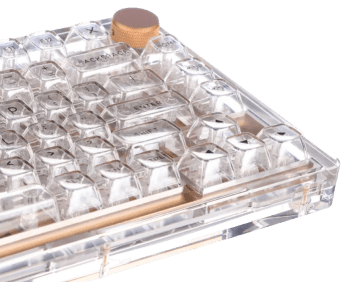
The Phantom 81 is an 81-key, 75% layout mechanical keyboard. It has a volume knob/dial, which you should know by now, I’m always pleased and impressed with. It’s Windows and Mac compatible (a two-way switch on the rear, next to the USB port, selects the mode). The Phantom 81 is ANSI layout only. I haven’t used an ISO layout board since I was typing on the TH96 a few months back, and I’m very used to ANSI now anyway, so that’s not a problem for me. 81 keys mean you get all your Function keys, your arrow keys, and, yes, a Del key (which is something I prefer not to do without when typing).
You can connect to the Phantom 81 one of three ways: via Bluetooth 5.0, 2.4Ghz wireless (USB dongle stashed in a nice little niche under the board), and via standard USB Type-C. A three-way switch at the rear of the board allows you to switch between modes. If you’re using the Phantom 81 wirelessly, the onboard 4000mAh battery is going to last around 60 hours of continuous use with the RGB lights on, and 100 hours with them off.
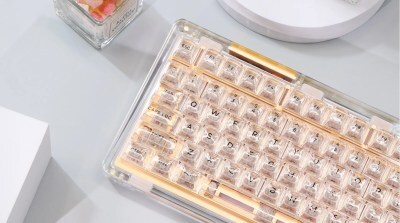 The Phantom 81 comes in a choice of three colourways: Clear Black, Clear Yellow, and Clear. I got Clear, and it really is clear. Transparently clear. The Crystal Keycaps are fully transparent with bold, yet elegant, black characters. The base is made of transparent acrylic through which you can see the gold-coloured plate which sits below the transparent switches. Oh, did I forget to mention that the volume knob is gold-coloured aluminium too? The little plate at the rear of the board which houses the USB port and switches is also gold-coloured, as is the KiiBOOM logo plate on the underside of the board. As I said, the Phantom 81 is pretty classy.
The Phantom 81 comes in a choice of three colourways: Clear Black, Clear Yellow, and Clear. I got Clear, and it really is clear. Transparently clear. The Crystal Keycaps are fully transparent with bold, yet elegant, black characters. The base is made of transparent acrylic through which you can see the gold-coloured plate which sits below the transparent switches. Oh, did I forget to mention that the volume knob is gold-coloured aluminium too? The little plate at the rear of the board which houses the USB port and switches is also gold-coloured, as is the KiiBOOM logo plate on the underside of the board. As I said, the Phantom 81 is pretty classy.
The Phantom 81 comes loaded with KiiBOOM’s own Crystal Switches, which are Linear switches that feel a lot (to me) like Cherry MX Silent Reds. They are, however, not silent, but pleasantly clicky. Exactly clicky enough, I’d say. They are also completely transparent. The Phantom 81 is a hot-swappable keyboard, meaning that you can easily exchange the out-of-the-box switches for those of your own choosing with no need for any soldering or unnecessary messing. But the Crystal Switches feel lovely to me. Perfect typing switches.
 Like the MC66 which I tried out recently (which feels a bit like a Junior version of the Phantom 81 in many ways), the Phantom 81 has two separate, independently controlled sets of lights: south-facing RGB LEDs behind the keys, and a rectangle of RGB LEDs in its transparent base. There are an absolute tonne of presets for both sets of lights, and they’re further customisable using KiiBOOM’s own software.
Like the MC66 which I tried out recently (which feels a bit like a Junior version of the Phantom 81 in many ways), the Phantom 81 has two separate, independently controlled sets of lights: south-facing RGB LEDs behind the keys, and a rectangle of RGB LEDs in its transparent base. There are an absolute tonne of presets for both sets of lights, and they’re further customisable using KiiBOOM’s own software.
If you’ve read my reviews before, you’ll know I usually end up switching to a solid colour rather than a flashing light show, no matter how impressive the lights are. The Phantom 81‘s lights are really, really impressive. However, the transparent keys and base of the Phantom 81 made the lights extra distracting for me. So much so, that I was actually finding it hard to type with some of the more flamboyant presets. For me, where the Phantom 81 really shines (if you’ll pardon the pun) is with the solid colour settings. White light really emphasises the jewel-like look of the keyboard, but you can easily set the Phantom 81 to whatever colour scheme you fancy to perfectly match your desk or workspace.
 The Phantom 81 weighs just shy of 1.5 kg on my kitchen scales, so it’s a real heavyweight keyboard. It’s a Gasket Mounted board, with additional poron foam layers, to strengthen and “acoustically enhance” your typing experience. What does any of that actually mean? It means that pretty much none of your typing force is transferred through the keyboard into the desktop or whatever surface you’re typing on. The Phantom 81 adsorbs and deadens the force of even the heaviest keystrokes, emitting nothing but the pleasant click of the shining Crystal Switches.
The Phantom 81 weighs just shy of 1.5 kg on my kitchen scales, so it’s a real heavyweight keyboard. It’s a Gasket Mounted board, with additional poron foam layers, to strengthen and “acoustically enhance” your typing experience. What does any of that actually mean? It means that pretty much none of your typing force is transferred through the keyboard into the desktop or whatever surface you’re typing on. The Phantom 81 adsorbs and deadens the force of even the heaviest keystrokes, emitting nothing but the pleasant click of the shining Crystal Switches.
The Phantom 81 is a really, really good keyboard. It’s lovely. It’s perfect, really. My only problem with it – and this is definitely a me problem – is that it actually feels too high-class for me. Metaphorically, I feel like I’m driving some bin-bags to the city dump in a Lamborghini, or badly playing Iron Man over and over on Prince’s own custom-made purple Jerry Auerswald guitar.

Technically, the Phantom 81 is perfect. Could not be better. An absolute pleasure to work on. Aesthetically, it is absolutely beautiful. A gorgeous, bejewelled, slab of glittering loveliness. If you feel worthy of having something which radiates glamour and sophistication on your desktop, then this is the keyboard for you.
The Phantom 81 is available to order direct from KiiBOOM for $159 USD / £132 GBP
The post KiiBOOM Phantom 81 keyboard first appeared on moorereppion.February 27, 2023
MechLands MC66 keyboard
The always generous people at Epomaker very kindly sent me a MechLand MC66 keyboard to try out.
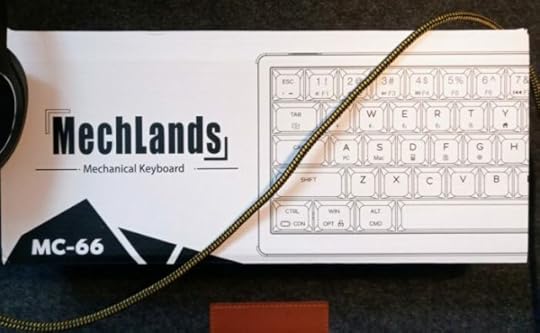 The MC66 is a 65% 66 key keyboard with an in-built media volume knob (push-click to mute/unmute). If you’ve read my reviews before, you’ll know that I’m a fan of a 65% board and a designated vol knob, so we’re already off to a good start!
The MC66 is a 65% 66 key keyboard with an in-built media volume knob (push-click to mute/unmute). If you’ve read my reviews before, you’ll know that I’m a fan of a 65% board and a designated vol knob, so we’re already off to a good start!
The MC66 comes in a choice of black or white colourways. I got white which comes with the out-of-the-box options of Gateron Pro Yellow, Epomaker Flamingo, or Epomaker Budgerigar switches. I got Flamingos, which are linear, and a little bit smoother than I’m used to. The switches on the MC66 are fully hot-swappable, meaning that you can easily replace them with the 3 or 5 pin switches of your choice with no need for soldering or any technical messing about.
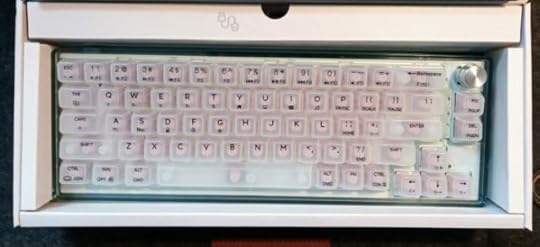
The very-nearly-but-not-quite-fully transparent keycaps on the MC66 are made of hard-wearing polycarbonate (PC) with non-embossed characters printed on to them. The keycaps have a standard OEM profile. If I had to nitpick, I’d say that the keycaps are just a tiny bit too smooth and glossy feeling for my taste, but that’s not a problem, just a matter of personal preference.
The MC66 is ANSI layout only which, on a 65% board, would usually would mean that I was missing my Del key. However, the MC66 does have a designated Del (Ins/Pg Up and Del/Pg Dn are top right of the board, directly under the vol control) so I can’t complain. It’s true that it’s not exactly where my muscle memory expects it to be, but really that’s my own fault for switching keyboards too often.

The MC66 is steel plate-mounted on a transparent polycarbonate base, making the keyboard feel really solid. Dual layer sound absorbing silicone pads ensure that, even when you’re hammering away, the MC66 really is incredibly quiet. The typing angle can be adjusted utilising a pair of sturdy flip-down PC feet with non-slip silicone pads. It’s a robust, stable board on the desktop (weighing in at about 1 kg), and it’s not going anywhere.
The MC66 is compatible with Windows and Mac (toggle between these using Fn+A and Fn+S with the mode indicated by mini LEDS over on the right of the board), and well as Android and iOS. Connectivity comes wired via standard USB-C, Wireless 2.4Ghz (dongle stashed in a nice little niche under the base), and Bluetooth 5.0. With three memory slots to store and recall Bluetooth connections, this means that the MC66 can easily toggle between 5 different devices.
The MC66‘s large capacity 4000mAh battery will apparently last you 220 hours of continuous use without RGB lights (I’ll get to the lights in a little while). There’s an on/off switch for the battery tucked away under the base, which is a nice touch. It can be annoying to have your unplugged keyboard flashing away in your bag while you’re carrying it around, losing charge all the while. There’s a designated battery indicator LED over there next to the Mac/PC lights which tells you whether you’re charged, low on charge, or charging. Not a terribly exciting detail, I know, but genuinely useful nonetheless. When running on battery power, after 5 mins of inaction, the MC66‘s RGB lights will automatically turn off, and after 30 mins of inaction, the keyboard will shut down completely.
The MC66 has not one but two separate sets of lights – one set in its transparent PC base, and one set backlighting the keys. Both of these can be independently customised; choosing from in-built lighting effects, or solid colours, or else using Macro settings to create your own (I’m neither clever nor confident enough to mess with Macros stuff, so I can’t advise you any further on that, sorry). The speed of the effects and the brightness of RGB lights on both sets can also be independently adjusted. This incredible level of customisation means that the MC66 can basically be any colour of keyboard you want. Well, okay, not absolutely any colour, but a transparent keyboard and keys + two sets of independently adjustable RGB lights = lots and lots of possibilities. Using the MC66 for gaming? Fn+G enters Game Mode, illuminating only the WASD and arrow keys.
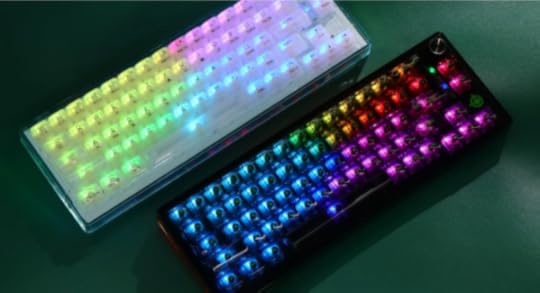
In terms of form, the MC66 feels very compact, even for a 65% keyboard, but nothing is missing, and the layout doesn’t feel cramped or unintuitive to use. Its smallness and neatness, as well as its quietness, feel somehow at odds with the sheer heft of the MC66. Weirdly, the whole thing kind of reminds me of the “is it cake?” phenomenon; visually, the MC66 gives you one impression, but what’s inside is very different.
The MC66 is a really, really solid 65% desktop board with absolutely nothing missing, but it also has more bells and whistles than your average gaming keyboard. Maybe it will be a little on the heavy side for some people who want a compact, portable keyboard for their laptop bag but, other than that, it’s hard to find fault with this little powerhouse.
The MechLands MC66 is available to order from Epomaker for $99 USD
The post MechLands MC66 keyboard first appeared on moorereppion.


